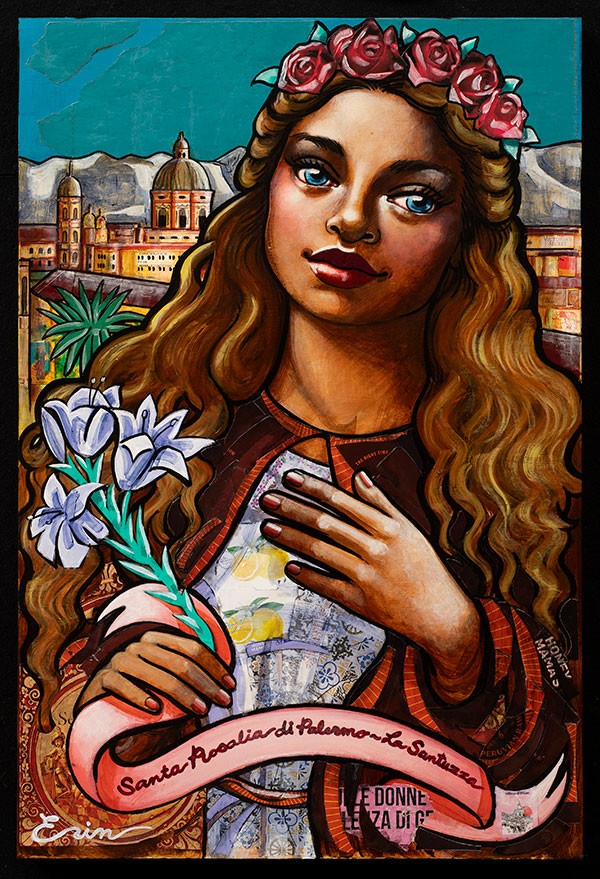Erin Currier
Santa Rosalia de Palermo
Acrylic and mixed media on panel, 36"h x 24"w, Item No. 22761,
Rosalia (1130–1166), nicknamed la Santuzza ("the Little Saint"), is the patron saint of Palermo in Italy. She is especially important internationally as a saint invoked in times of plague. From 2020 onwards she has been invoked by some citizens of Palermo to protect the city from COVID-19.
This portrait is part of my ongoing celebration of female saints.
My quest to highlight the extraordinary within the ordinary individual life, has led me over the years to portray Bodhisattvas, civil rights workers, various others involved in emancipatory efforts, &, ultimately, female Catholic saints. I have found that many female saints, the saints I’ve portrayed in particular, were autonomous thinkers—i.e., they were non-conformists, free-thinkers, who often outright defied, authorities & institutions- ie the “status quo”- of their eras. The spiritual quality associated with these saints is one of “immanence versus transcendence”: the idea of finding God or the sacred “within” oneself as opposed to the “without” as manifested by the institutional religious authority imposed by the Church. In the same way that I attempt to transform humble materials into aesthetic works of art; these women often led humble and quietly compassionate lives that were, nonetheless, admirable enough for their peers to pressure the church on behalf of their transformation into sainthood. In this sense, these female saints were “beatified from below”—i.e., it was through the mandate of the people that these women were declared saints by the Vatican, not the other way around..
Rosalia was born of a Norman noble family that claimed descent from Charlamagne. Devoutly religious, she retired to live as a hermit in a cave on Mount Pellegrino, where she died alone in 1166. Tradition says that she was led to the cave by two angels. On the cave wall she wrote "I, Rosalia, daughter of Sinibald, Lord of [Monte] delle Rose, and Quisquina, have taken the resolution to live in this cave for the love of my Lord, Jesus Christ."
In 1624, a plague beset Palermo. During this hardship Rosalia reportedly appeared first to a sick woman, then to a hunter, to whom she indicated where her remains were to be found. She ordered him to bring her bones to Palermo and have them carried in procession through the city.
The hunter climbed the mountain and found her bones in the cave as described. He did what she had asked in the apparition. After her remains were carried around the city three times, the plague ceased. After this Rosalia was venerated as the patron saint of Palermo, and a sanctuary was built in the cave where her remains were discovered.
Her post-1624 iconography is dominated by the work of the Flemish painter Anthony van Dyck, who was trapped in the city during the 1624–1625 quarantine, during which time he produced five paintings of Rosalia, now in Madrid, Houston, London, New York and Palermo itself. In 1629 he also produced Saint Rosalia Interceding for the City of Palermo and Coronation of Saint Rosalia to assist Jesuit efforts to spread devotion to her beyond Sicily.
In my portrait celebrating her, I’ve collaged my plane ticket to Palermo; a sugar packet from Palermo; torn posters from Italy; a Thai takeout box; Honey Mama’s chocolate; a silverware wrapper from Sicily; & more…






